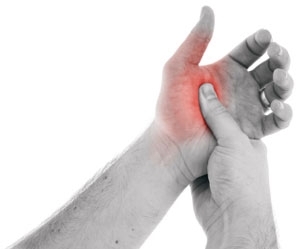Overuse Injuries
What are Overuse Injuries?
Work-related overuse injuries, as defined by the US Department of Labor, are injuries or disorders of the muscles, nerves, tendons, joints, cartilage, and spinal discs associated with exposure to risk factors in the workplace (Barbe & Barr, 2006). Musculoskeletal disorders include sprains, strains, tears, back pain, soreness, pain, and musculoskeletal system, or connective tissue disorders. The predisposing event leading to the injury or illness is the body's response to bending, climbing, crawling, reaching, and twisting. Injury can also occur due to overexertion or repetition of similar motions over time.
The pathophysiology of overuse injuries is based on the idea that tissues adapt to the stress placed on them over time (Laker, Sullivan, & Strum, 2013).
What are the Signs and Symptoms of Overuse Injuries?

- Numbness or tingling in the hands or feet
- Decreased joint motion or a feeling of stiffness
- Redness or swelling
- Burning
- Pain that worsens over time at work
- Weakness
- Clumsiness
- Cracking or popping of joints
- Aching
- Difficulty sustaining postures at work
- Difficulty gripping, carrying, typing, or completing other work tasks
Risk Factors for Overuse Injuries
- Overexertion or repetitive motions
- Poor posture
- Improper lifting techniques

Psychosocial factors have been implicated in overuse injuries for decades. A partial list includes work satisfaction, perceived physical health, perceived mental health, coping mechanisms of the patient and his/her family, perception of work-readiness, and anxiety.
In addition to physical and psychosocial factors, the economic impacts of overuse injury in the workplace is immense. The indirect impact is nearly incalculable if the number of health care dollars involved is considered. One interesting review of worker demographic data suggested that workers with overuse injuries were subjected to employment discrimination. Depression and quality-of-life issues have also been described after a diagnosis of chronic overuse injury.
Risks of Inactivity During the Workday:
As a whole, more Americans have sedentary jobs today than ever before. Technological advances have changed the work culture, and sedentary jobs have increased 83% since 1950. Physically active jobs only make up about 25% of our workforce.
Current research has identified the effects of a sedentary lifestyle. One study performed at the Mayo Clinic concluded that spending extended periods of time sitting, whether it be at your desk or in the car, can be harmful to overall health. In fact, it was recently reported that inactivity is responsible for more annual deaths than smoking.
Physical inactivity has been shown to contribute to several health conditions:
- Cancer (10% increased risk breast cancer and colon cancer)
- Anxiety and depression
- Cardiovascular diseases (high blood pressure and elevate cholesterol levels)
- Overweight or obesity
- Diabetes
- Decrease skeletal muscle mass
- Decreased bone density
The positive is that this is preventable by getting up and moving more throughout the day!

Incorporating Activity Into the Work Day:
The easiest place to incorporate increased activity during the day is at work, where the average individual spends up to eight hours or more sitting. Getting up frequently throughout the workday can combat the negative effects of sitting. Health professionals advocate for taking five minutes to stand for every 30 minutes of sitting to prevent overuse disorders (Rutten, Savelberg, Biddle, & Kremers, 2013).
Regular exercise outside of the workday is also crucial to maintain your health, no matter how active you are during the workday. The American Heart Association recommends 150 minutes of moderate activity during the week for adults. For more information on a fitness program right for you, talk to your doctor or a local physical therapist.
References:
1.) Barbe MF, Barr AE. Inflammation and the pathophysiology of work-related musculoskeletal disorders. Brain, behavior, and immunity. 2006;20(5):423-429. doi:10.1016/j.bbi.2006.03.001.
2.) Laker SR, Sullivan WJ, Strum S. Overuse Injury. Accessed February 12, 2015. Available at: https://emedicine.medscape.com/article/313121-overview#showall.
3.) Health Risks of a Sedentary Lifestyle. 2013. Accessed February 2, 2015. Available at: https://www.lifespanfitness.com/workplace/resources/articles/health-risks-of-a-sedentary-lifestyle
4.) Rutten GM, Savelberg HH, Biddle SJ, Kremers SP. Interrupting long periods of sitting: good STUFF. International Journal of Behavioral Nutrition and Physical Activity, 2013; 10:1. Available at: https://www.ijbnpa.org/content/10/1/1.
